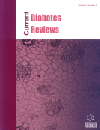- Home
- A-Z Publications
- Current Diabetes Reviews
- Previous Issues
- Volume 14, Issue 1, 2018
Current Diabetes Reviews - Volume 14, Issue 1, 2018
Volume 14, Issue 1, 2018
-
-
Stem-cell-based Therapies for Improving Islet Transplantation Outcomes in Type 1 Diabetes
More LessAuthors: Joao P.M.C.M. Cunha, Conny Gysemans, Pieter Gillard and Chantal MathieuIntroduction: Beta-cell replacement by human islets or whole pancreas offers a life-saving therapeutic remedy for patients suffering from type 1 diabetes, providing considerable advantages with respect to diminishing total daily insulin dose and lowering frequencies of debilitating hypoglycemic reactions as well as preventing chronic micro- and macrovascular complications. Although remarkable progress has been Read More
-
-
-
Type 1 Diabetes Treatments Based on Stem Cells
More LessAuthors: Miriam Arana, Anujith Kumar, Ashwini Ashwathnarayan, Maher Atari and Miguel BarajasBackground: More than a decade ago, a new research field named Stem Cell Therapy emerged in Health Science. Initially, it was considered that cells owned a differentiation capability; however, this dogma has changed when new results have been published regarding the ability of the cells to differentiate into different cell tissue mainly due to the novel reprogramming strategies. Accordingly, cells from an adult tissue source m Read More
-
-
-
Functional Profiles of Human Umbilical Cord-Derived Adult Mesenchymal Stem Cells in Obese/Diabetic Versus Healthy Women
More LessBackground: Adult human mesenchymal stem cells retrieved, from the post-partum human umbilical cord Wharton jelly (hUCMS), have recently gained growing interest due to their morphological and functional properties. Objective: The main purpose of our work was to examine morphology and functional properties of hUCMS retrieved from healthy women as compared to those with obesity, or gestational or type 2 diabetes Read More
-
-
-
Isolated Compounds from Natural Products with Potential Antidiabetic Activity - A Systematic Review
More LessAuthors: Antonio C.M. Munhoz and Tania S. FrodeBackground: Worldwide, Type 2 diabetes has become a growing health problem. While many research articles in the field of ethnopharmacology have focused on the antidiabetic properties of medicinal plant species, insufficient evidence remains regarding their therapeutic use. Studies using both in vitro and in vivo models are necessary to evaluate various medicinal plants species, used in folk medicine, by using scientific crit Read More
-
Volumes & issues
-
Volume 21 (2025)
-
Volume 20 (2024)
-
Volume 19 (2023)
-
Volume 18 (2022)
-
Volume 17 (2021)
-
Volume 16 (2020)
-
Volume 15 (2019)
-
Volume 14 (2018)
-
Volume 13 (2017)
-
Volume 12 (2016)
-
Volume 11 (2015)
-
Volume 10 (2014)
-
Volume 9 (2013)
-
Volume 8 (2012)
-
Volume 7 (2011)
-
Volume 6 (2010)
-
Volume 5 (2009)
-
Volume 4 (2008)
-
Volume 3 (2007)
-
Volume 2 (2006)
-
Volume 1 (2005)
Most Read This Month
Article
content/journals/cdr
Journal
10
5
false
en


